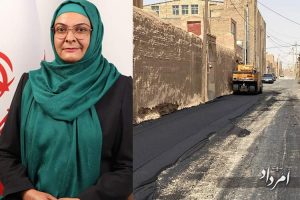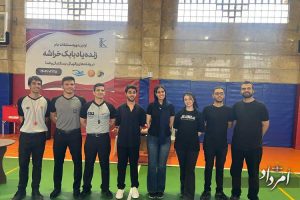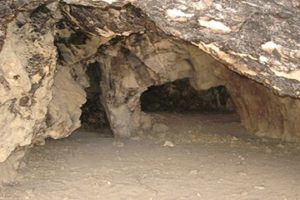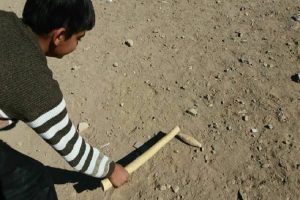Head of the Iranian archeology group of Viranshahr ruins in Farouj, announced the discovery of a shrine’s remains in the area’s central hill, and said: “Viranshahr had signs of administrative, religious and a tax collection center during the Parthian period.”
According to Ilna, the ruins of Viranshahr, located in the west of Titkanlu city and 10 kilometers of Farouj County, is one of the most important historical sites of Atrak Valley, whose importance has long been recognized by archaeologists. The Italian archeologists, who had identified this area before the revolution, had suggested a period close to the Sassanid era. Finally, it was also registered in the national heritage list. However, the current excavations, which began in 1398 (2019) with the efforts of a group of Iranian archaeologists and with the cooperation of French archaeologists in the framework of the collaboration between the Research Institute of Cultural Heritage and Tourism and the Louvre Museum, showed that the time of the foundation of the tower and rampart of this settlement was the Parthian period, and the establishment in it until The middle of the Sasanian period has continued.
Architectural transformation of the structure
Meysham Labaf Khaniki, the head of the Iranian archeological team of the ruins of Farouj, pointing out that the fifth season of exploration and speculation in this area ended some time back, said: It was more or less from the third season of investigation that we found out that the remains of the architecture of the structures show that the area of the remains was surrounded by a square fence and covered an area of 14 hectares, each side of which is 350 km. The surrounding wall of this settlement had many towers, and a citadel or ruler’s seat was located in its northwest corner. The structure of the gate and additional structures underwent transformations during at least three architectural periods, which, according to the obtained signs, lasted from the beginning of the Parthian period to the middle of the Sassanid period. As a result of exploring the fourth chapter, the gate structure, including the entrance passage and side rectangular cube towers, was identified.
He said: “Now, with the help of the North Khorasan heritage and tourism department, a par of the gate has been repaired and restored for the public to visit and to become a museum site. In other words, the tower of the Parthian period is being prepared for everyone to visit so that tourism in the region can flourish.”
Labaf Khaniki said about the fifth season of exploring the area of Viranshahr in North Khorasan: This year, we focused our work on the hill inside the area. Finally, the characteristics of the architectural plan, usage and building materials on this hill were identified. The general architecture of the complex shows that it was made using adobe walls, and the characteristic of the adobe also delivers the feature of Parthian and Sassanid period architecture. These findings strengthen the suggestion that these buildings were built in the Parthian period and used until the Sassanid period.
Use until the Sassanian period
In response to the question asking whether the findings indicate that the site was residential, the head of the Iranian archeology team of the ruined site of Farouj said: No; All of this 14-hectare area, which was used until the middle of the Sasanian period, looked same as the administrative centers in the parthian and sassanid period, and it is known as the administrative center. We have several other examples of these enclosures in Khorasan, which were administrative centers and managed and organized surrounding populations, including satellite villages and nomads.
He believes that part of this area, known as the ruined city, was an administrative and political center, and the other part is a religious structure. In others words, the ruler’s policy to have both religious and administrative sectors together, were implemented in this complex. The hill inside the compound is probably a temple. Because in various parts of Central Asia, such as Kharazm, Transoxiana, etc., we had plans similar to this building, which had a religious use. Even Khajeh Sisistan Mountain, the well-known fire temple of the Parthian period, one of the oldest fire temples, has such a plan, which shows that it is a place of worship with religious use. Symmetry plays the primary role in all these plans.
In response to whether traces of a fire temple were found in this part of the remains of Viranshahr, he said: The difference between this building and other known architectural complexes is that a lot of height has been left from the building. Nearly four and a half meters from the structure’s height is buried. It can be said that we have a relatively healthy system under the roof arch in this section, but now we cannot easily reach the floor of the building; because a large part of the building is buried under the soil, and extensive excavation must be done in this area. At present we could only determine the floor’s plan and level and have an idea about its use. If objects are obtained, and cultural materials are in this area, the whole space must be excavated to get these works. This is while facing a 12 x 12-meter hall with a 12 x 12-meter porch. The scales are vast, and if we want to get to the bottom and find traces of the fire pit or the works done in this sector, a large-scale excavation should be done with the volume of extensive excavation. The value of this building makes it essential to do such a thing.
In response to the question that: it is often noted that on the fire temple wall and religious centers of the Parthian and Sasanian periods, color and painting are visible, have there been any traces of paint found in this place that show the correct use of this complex as a temple fire place, he said: “This is an important point because red is found in the examples in Turkemanistan, but the point is that these paintings, also, are used in the lower part of the wall. Now we know that the walls are plastered, and to get traces of paint or painting; exploration should be done to the lower spaces because these colors were generally used at the level of one meter of the walls. These parts of the excavations will be given priority in the coming years, and if there is enough support, we will be able to talk without speculation.”
Viranshahr, an economical and administrative center
Regarding the area’s expansion and whether it could have been one of the prominent centers of power in the Parthian and Sasanian periods for the administration of Great Khorasan. This archeologist said: We have a good document, such as Nesa inscriptions, located 60 km from Viranshahr. In these inscriptions, various settlements paid taxes. Viranshahr is one of the administrative and economic centers that collected taxes and delivered them to the main center, Nesa. Viranshahr was a minor part of the satrapies of the Achaemenid period.
Labaf Khaniki continued: If the excavations in Viranshahr continue and we can reach the lower layers, we might also get the pottery inscriptions. Of course, considering the earthquake that happened in the area, it is believed that after the earthquake, the area was slowly evacuated and abandoned over time. Therefore, very few movable cultural materials were found in the area. We hope to see the administrative documents of that period.
The head of the Iranian archeology group of the Farouj ruined site said about collaborating with the Louvre museum. Since 1398 (2019), when the memorandum was signed, we have yet to have the residence of the French colleagues for various reasons. But we have their scientific cooperation, and the laboratory tests of the data are done with the help of the Louvre Museum. Considering that the fifth chapter was the last chapter based on the five-year agreement, this agreement has ended in practice, and we hope that the understanding and support for this exploration will continue due to the remarkable findings. It should not be forgotten that so far, such sites have been found outside the borders of Iran, from Turkmenistan to Uzbekistan and northern Afghanistan, and have been explored with the help of foreign archaeologists, and this is more or less the first example of its kind to be explored within the borders of Iran and with the help of Iranian archaeologists. For the first time, we are faced with the culture of the Parthian period and the way of the political and religious central administration, which will not be ineffective in reading and retelling history.










